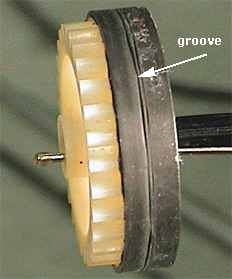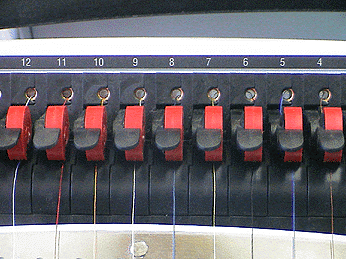![]()
One problem you might experience with the thread feeder is thread wrapping around the thread feeder roller, similar to birdnesting that sometimes occurs around the rotary hook. This is caused primarily when the thread sticks to the rubber belt on the thread feeder roller, is pulled through the opening of the front thread feeder cover and wraps around the roller. This can also occur if the rubber belt on the thread feeder roller is damaged or worn, and increases in frequency and severity if either the thread feed or material feed settings are set incorrectly in AMAYA OS (set too high).
The AMAYA thread feed rollers are consumable parts (need to be replaced periodically) because they wear out. Wear of the rubber on the thread feeder roller can occur because of the following reasons:
The rubber on the thread feeder roller is damaged quickly if the thread is pulled through by hand without lifting up the lever (pinch roller) before pulling the thread through. This leads to rough spots and nicks on the rubber belt, which will catch thread and pull it inside through the cover, causing birdnesting inside the thread feeder. For these reasons, it is important to pay careful attention to the thread and material feed settings.
Metallic and cotton blend threads can cause thread feeder rollers to wear out more quickly than Rayon or Polyester threads.
Thread feeder rollers of needles that are used the most frequently will wear our more quickly than others.
Tighter tension can cause thread feeder rollers to wear out more quickly.
If you are experiencing any of the following problems, it is recommended that you check the thread feeder rollers. It is possible that worn out rollers could be the source of the problem.
Birdnesting inside the thread feeder
Thread breaks
Inconsistent looking bobbin on the back of embroidery
Looping stitches
Skipped stitches
If you can easily pull thread without lifting the pinch roller, you need to inspect the thread feeder roller for wear/damage.
After the roller is removed, inspect it for nicks or a groove in the rubber (the following image displays a roller with a groove in the rubber). If the roller is damaged or worn, and you are experiencing any of the problems listed above, it needs to be replaced.

It is possible for rollers to become coated with silicone (from certain threads, such as rayon thread). This silicone makes the surface of the roller very slick. If needed, use a clean cloth to remove the silicone coating from the surface of the roller.
If you are experiencing problems such as birdnesting inside the thread feeder, thread breaks, inconsistent looking bobbin on the back of embroidery, looping stitches, and skipped stitches, it is recommended that you inspect the red pinch rollers of the thread feeder system.

It is possible for these pinch rollers to become worn over time, and wear on these rollers can affect their operation.
Follow the guidelines in the table below to troubleshoot thread feeder issues.
|
Problem |
Probable Cause |
Solution |
|
Thread wrapping around thread feeder roller Clear the resulting "birdnesting" in the thread feeder following the procedures shown in Clearing Thread from Thread Feeder Roller |
Thread feed setting too high |
Decrease the thread feed. (See Thread Feed Tab) |
|
Material thickness setting too high |
Decrease the material feed. (See Thread Feed Tab) |
|
|
One of settings on the "Color Settings" tab in AMAYA OS too high. |
Lower this setting. (See Color Settings Tab.) |
|
|
Nicked or damaged thread feeder roller |
||
|
Damaged rubber pad on roller |
Pulling thread through without lifting up the roller. (This creates a groove in the rubber pad or cuts it). |
|
|
Broken thread feeder arm |
Excess force applied to thread feeder arm |
|
|
Deep groove in red pinch roller |
Normal wear |
|
|
Jumpy or uneven thread feed |
Broken teeth on drive gears. |
Inspect thread feeder gears for broken teeth or other damage. If there is any damage to the gears, replace the thread feeder assembly. If the thread feeder gear on the thread feeder stepper motor is damaged, replace it. If the gears in the thread feeder assembly are damaged, replace the thread feeder assembly. |
|
Thread feeder out of adjustment. |